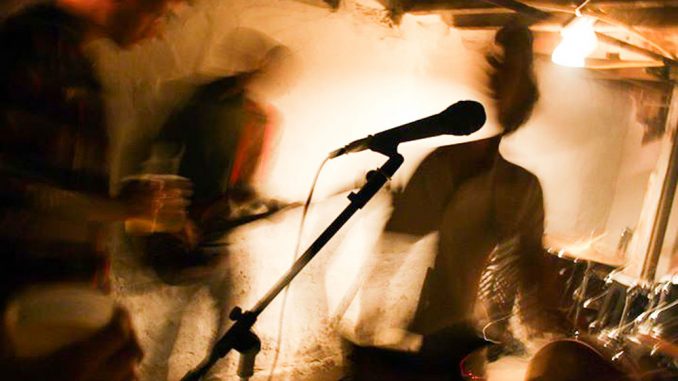
To Kill a King, an English folk rock outfit, is gearing up to play a litany of festivals this summer. Included on the itinerary are Belgium’s Pukkelpop, Germany’s Hurricane Festival and the UK’s Lubstock.
The band will be sharing the stage with the likes of OutKast, Slowdive, Arcade Fire and a slew of others. However, last March, the quintet was setting up shop to perform in a quaint Fishtown living room.
At the behest of Sofar Sounds Philadelphia, a global organization dedicated to bringing intimate shows to people’s homes, To Kill a King performed to a crowd of cross-legged living room goers.
Quite a few stops away on the Market-Frankford line in University City, Nashville’s Bleed the Pigs performed at the Golden Tea House. A power-violence quartet with an afro’d female vocalist and a penchant for start-stop blast beating nuttiness, Bleed the Pigs sped through a set that captivated and brutalizes, as lightning-fast shredding intertwines with sludgy breakdowns. But not before they experience a litany of technical difficulties.
Casualties of the performance include two guitar heads and a cabinet. The four-piece spends more time fumbling with equipment than it does pulverizing. Still, the performance persists, and everyone is more than willing to lend a hand.
Surprisingly enough, the two sects of do-it-yourself seem to exist entirely unaware of each other.
“I think it’s rebelling against mainstream and rebelling against your parents even—like, punk.” said Anthony Perill, former housemate of the Double Deuce, a punk house situated in the heart of Temple’s Main Campus. “That’s how I always looked at it. Just the fact that shit’s going on is so bizarre.”
There are several entities that exist to bring living room shows to Philadelphia. SoFar Sounds: Philadelphia, an offshoot of the larger organization SoFar Sounds, is a stalwart. Carolyn Lederach, a 25-year-old freelance music consultant, is the organizations event coordinator. She said she believes that what they offer is good for both performer and audience.
“[It’s] just the idea of giving an artist an intimate space to perform where they not only know that they’ll have a set in crowd already, but also that the people who are there actually wanna be there just to be there and listen to music,” Ledearch said. “And not at a bar where people talk over people playing. That’s kind of the main goal we work off of.”
SoFar Sounds is a global entity that exists in over 40 cities. The lineups for events staged by SoFar generally are not announced. International acts such as the aforementioned To Kill a King and Prides have been brought to various Philadelphia living rooms at SoFar Philadelphia’s beckoning.
On the other end of the spectrum, Philadelphia’s house show scene is less homogenous. There’s a hodge-podge of groups and individuals keeping the movement alive. Guild Shows operate in both basements and sanctioned venues, and bring a bit of order to the madness. But for the most part, there is far less formality.
Price point is another place where living room shows and the prototypical DIY house show begin to deviate. Gigs put on by SoFar Sounds, according to Lederach, come at the cost of a $10 donation. However, this is not across the board.
Last fall, Cotton Jones—a two-piece psych act—staged a tour consisting of living room shows. Admission was placed uniformly at $15.
“I don’t think we had a show that was more than five dollars,” Perillo said. “It was $5 every time. I just think charging $15 for a band that’s playing at your house when you can just go to Union Transfer doesn’t make any sense. I don’t understand it.”
However, despite differences in prices, there are similarities. In the case of SoFar Sounds as well as the Double Deuce, all proceeds went to the bands.
Additionally, both of the two institutions rely entirely on the hospitality of music-loving strangers.
“Finding hosts is still a challenge most of the time,” Lederach said.” We try to switch up places but we have repeated spaces too. Most of the hosts have been people who have come to the shows and just wanted to open up their house. We’ve had other musicians open up their house. It’s just been varied people that are into the music that have wanted to be apart of it.”
But perhaps most importantly, both scenes find common ground when it comes to a sense of community.
“I think any time you bring a group of people together—no matter the circumstance—there’s definitely a sense of community,” Perillo said.
Lederach seemed to concur.
“We’ve never had issues with people. Everyone’s pretty friendly to each other, since I guess they’re all there for the same thing. They can kind of bond over that stuff.”
David Zisser can be reached at zisserd@temple.edu.


Be the first to comment